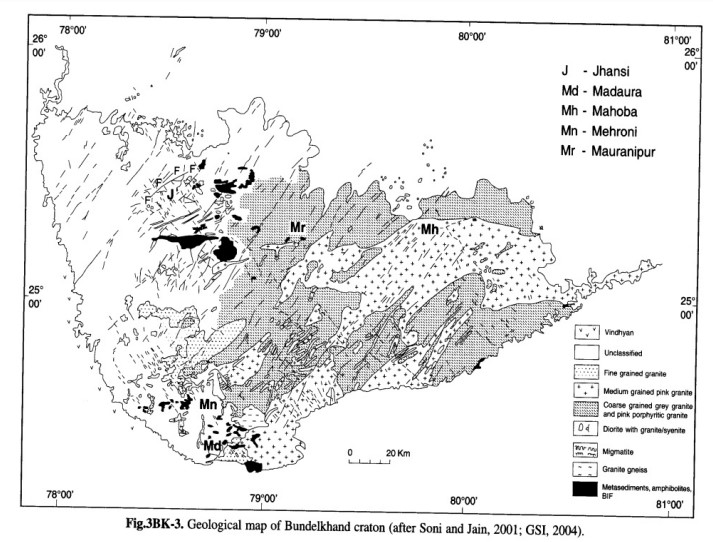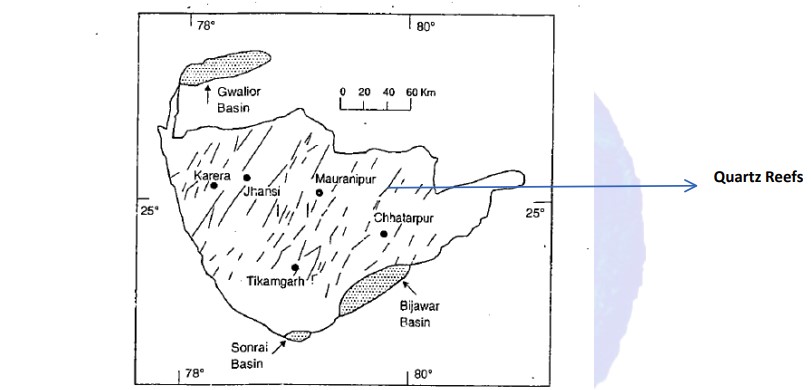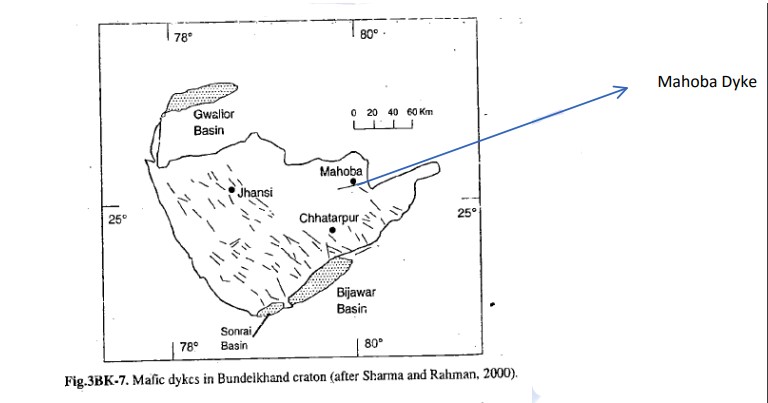What is the Bundelkhand Craton?
The Bundelkhand Craton is a 26,000 sq. km Archean cratonic block in central India, characterized by a triangular geometry with semi-circular sides. It is named after the 15th-century Bundelkhand kingdom. This geological formation contains tonalite-trondhjemite-granodiorite (TTG) gneisses dating from 3.55–2.5 Ga, Bundelkhand granite complexes, and distinctive supracrustal rock enclaves. The craton is bounded by the Son-Narmada lineament in the south, separated from the Aravalli craton by the Vindhyan basin in the west, and overlain by Indo-Gangetic alluvium in the north.
The Bundelkhand Craton, named for the fifteenth-century kingdom of Bundelkhand, is a triangular region with semi-circular sides. It is one of the Archean cratons in the Indian shield, covering 26,000 sq. km and bounded by the Son Narmada lineament in the south.

What are the geological boundaries of the Bundelkhand Craton?
The Bundelkhand Craton is:
- Separated from the Satpura mobile belt in the south.
- Separated from the Aravalli craton in the west by the Proterozoic Vindhyan basin.
- Overlain by the Indo-Gangetic alluvium in the north.
What are the main components of the Bundelkhand Craton?
- Enclave suite of supracrustal rocks within orthogneisses.
- Bundelkhand granite is associated with quartz reefs and rare felsic volcanic rocks.
- Mafic dyke swarms.
Paleoproterozoic and Meso-Neoproterozoic Basins
(a) Paleoproterozoic basins:
- Bijawar and Sonrai basins
- Harda Inlier
- Gwalior basin
Bundelkhand craton
(b) Meso-Neoproterozoic basins:
Vindhyan basin (Bundelkhand craton)
- (d) Bhander group (1300-1500m)
- (c) Rewa group (100-300m)
- (b) Kaimur group (400m)
- (a) Semri group (3000-4000m)
Supracrustal Rocks
What are Supracrustal Rocks?
Supracrustal rocks are rocks deposited on existing basement rocks of the crust. They may be further metamorphosed from both sedimentary and volcanic rocks.
Where are the prominent enclave belts located?
Two prominent east-west trending belts of the enclave are noticed:
- Northern Belt: Extending from Karera to Kabrai, Kuraicha, Jhansi, Mauranipur, and Mahoba.
- Southern Belt: Extending from Baraitha through Girar.
Other linear enclaves are noticed near Panna and Kalinjer. These belts have a regional trend of E-W with northerly dips.
What types of rocks are found in the enclave belts?
- Banded Iron Formation (BIF): Widespread around Girar and Baraitha.
- Amphibolites, Ultramafics, and Minor Quartzite, Metapelite, and Marble: Ultramafic rocks include peridotites, dunites, pyroxenites, and gabbros, closely associated with metabasic rocks and BIF.
- Metabasic Rocks: Most abundant, ranging from schistose metabasalts to low-grade amphibolites, some showing primary volcanic structures.
- Carbonate Rocks and Quartzites: Occur as scattered lenses and bands.
- Metapelites: Rare, containing garnet, biotite, and sillimanite.
Gneisses
What types of gneisses are present?
- Grey and Pink Banded (Stromatic-Migmatitic) to Streaky Gneisses: Occur as slivers, rafts, and narrow belts within vast areas of younger Bundelkhand granite. In stromatic gneisses, biotite and hornblende-bearing granodiorite melanosomes occur as bands or rafts in leucosomes.
- A basic enclave in the gneiss at Mahoba gave an age of 3250 Ma.
- The oldest gneissic component: Kuraicha 3.29 Ga.
- The youngest gneissic component: Panchwara 2.5 Ga.
Bundelkhand Granite
What types of granite are present?
- Coarse-Grained Porphyritic Granite
- Medium-Grained Porphyritic Granite
- Leucogranite
What are the characteristics of felsic volcanic rocks?
Associated with granites, these rocks occur in many places such as Mahoba, Bansi, and Simra near Prithipur. They are grey to pink, fine to coarse-grained, and porphyritic.
Quartz Reefs and Mafic Dyke Swarms
What is the significance of quartz reefs in the Bundelkhand Craton?
The emplacement of NE-SW trending giant quartz reefs along brittle shear zones probably marks the end-stage hydrothermal activity related to granitic plutonism. These reefs are spectacular landmarks in Bundelkhand Craton.

What are mafic dyke swarms?
A NW-SE trending swarm of mafic dykes is a characteristic feature of Bundelkhand Craton, with some dykes having an ENE trend, like the prominent Mahoba dyke. The geometry of the main dyke swarms is attributed to E-W shearing stress developed after cratonisation.

Relationship with Aravalli Craton
How are Bundelkhand and Aravalli cratons related?
Bundelkhand and Aravalli cratons were traditionally regarded as interlinked, with the Berach granite of Aravalli craton being considered equivalent to Bundelkhand granite.

Comparison
| Geochemical and Geochronological Comparisons between Bundelkhand and Aravalli Cratons | ||
| Features | Bundelkhand Craton | Aravalli Craton |
| Composition of the Gneisses | Tonalite, trondhjemite; highly fractionated REE patterns with depletion of HREE, small negative Eu anomaly | Tonalite, trondhjemite; highly fractionated REE patterns with depletion of HREE, small negative Eu anomaly |
| Composition of the Granitoids | Calc-alkaline, moderately fractionated REE pattern without HREE depletion, large Eu anomaly | Calc-alkaline, moderately fractionated REE pattern without HREE depletion, large Eu anomaly |
| Regional Metamorphism and Deformation | 3.29 Ga (oldest gneissic component; Kuraicha); 2.5 Ga (youngest gneissic component; Panchwara) | 3.28-3.3 Ga (oldest gneissic component; Mewar); 2.5 Ga (youngest gneissic component, Vali River) |
| Emplacement of Granitoids | ~2.5 Ga | ~2.5 Ga |
| Age of Stabilization | ~2.5 Ga; Sequential development of Mahakoshal and Vindhyan | ~2.5 Ga; Sequential development of Hindoli and Vindhyan |
| Mafic Rocks | Mafic dyke swarms | Mafic volcanics |
Mineralization
What minerals are commercially mined in the Bundelkhand Craton?
- Pyrophyllite
- Diaspore: Found as geodes, veins, and disseminations in pyrophyllite. The deposits are not large, with significant deposits in Jhansi district (230,000 tonnes) and Lalitpur (40,000 tonnes).
Where are significant diaspore deposits located?
The deposits occur at the junction of the Kuraicha and Palar formations of the Mehroni Group in the Bundelkhand block. Characterized by higher concentrations of Ti, Cr, and Zr—comparable with those of the gneisses—the deposits seem to be laterite-type products of the Mahoba-Baghora gneisses subjected to metamorphism up to 350°C.
What are the chemical compositions of diaspore and pyrophyllite?
- Diaspore: Al₂O₃·H₂O
- Pyrophyllite: Al₂Si₄O₁₀(OH)₂
